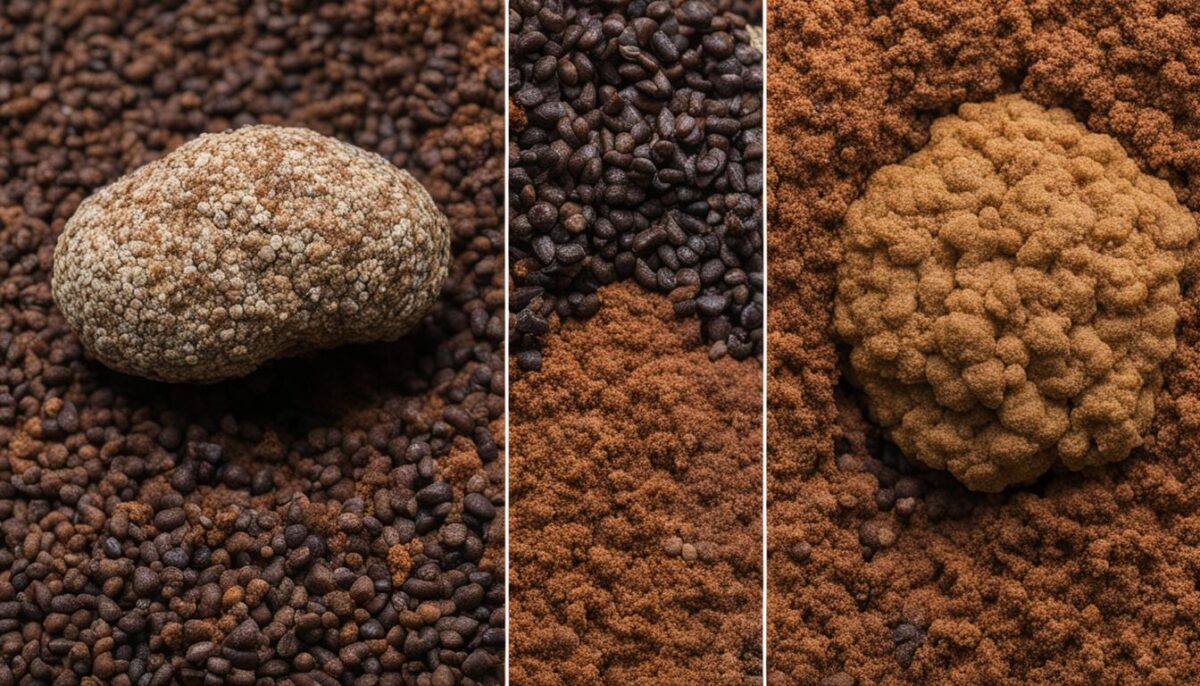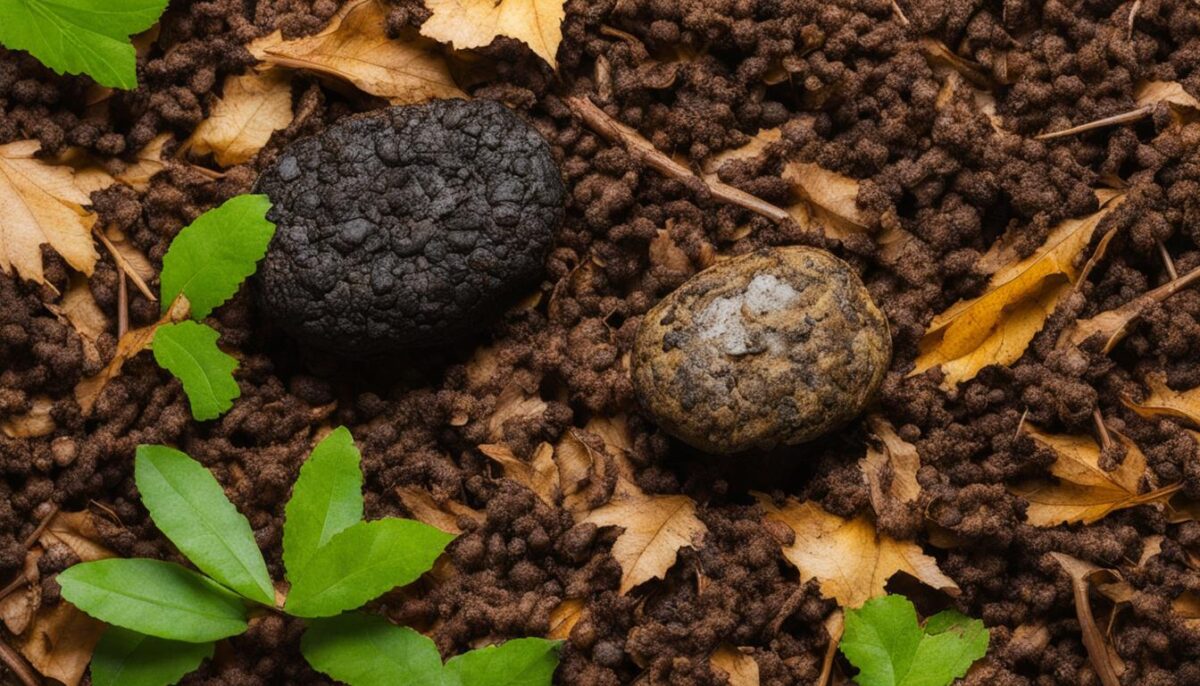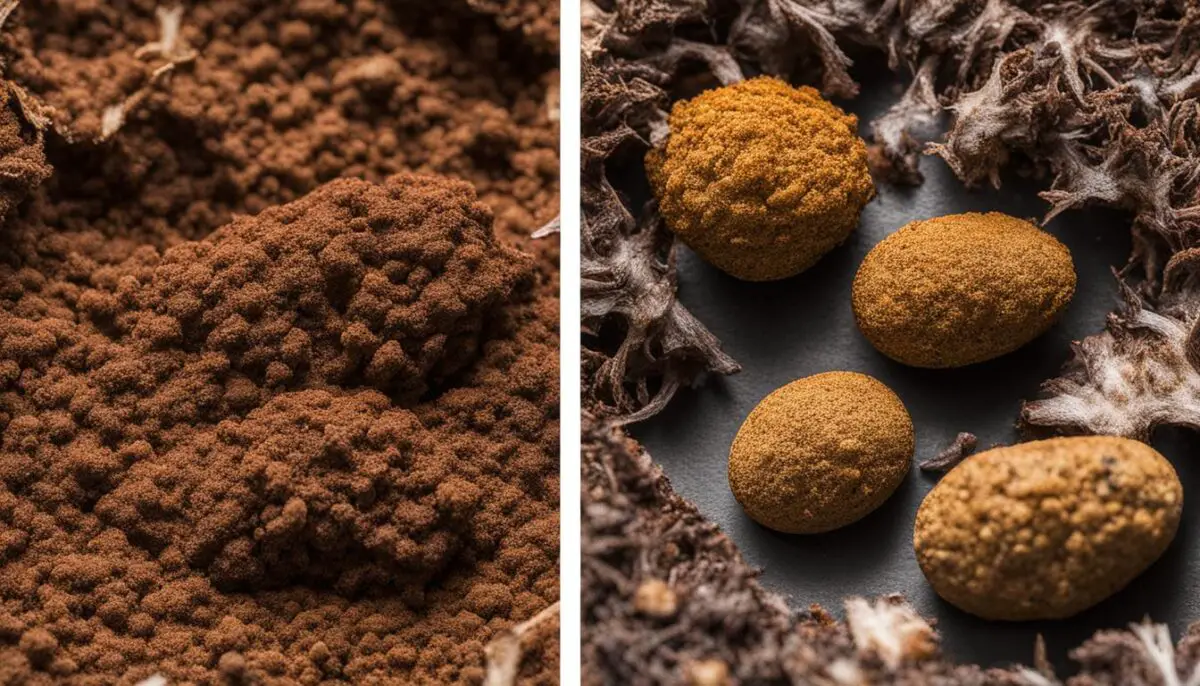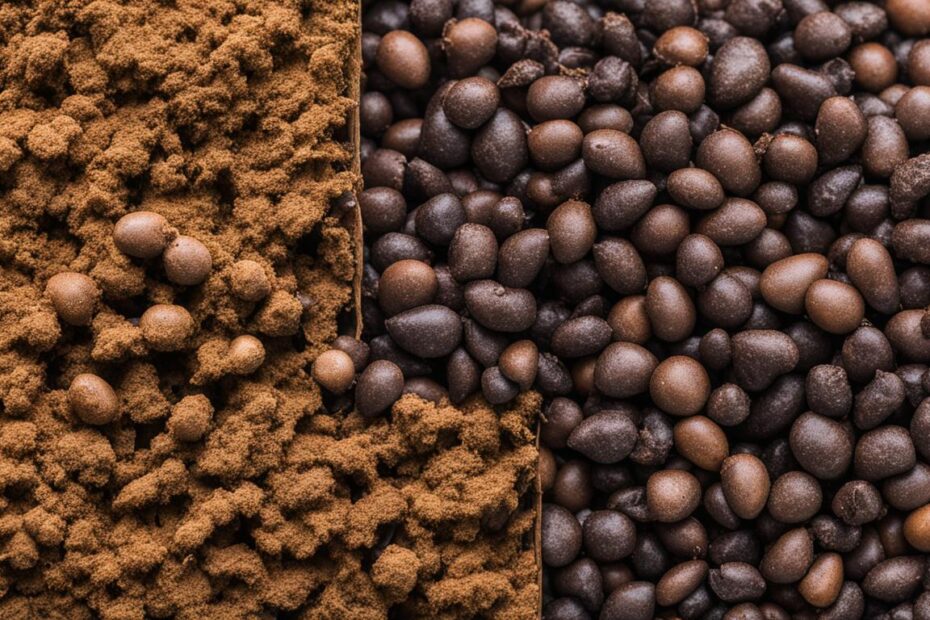Poop is not a topic that is commonly discussed, but it can be important to differentiate between different types of animal droppings, such as rabbit poop and deer poop. While the appearance of rabbit and deer poop may be similar at first glance, there are key differences that can help in identification. In this informative guide, we will explore the differences between rabbit and deer poop, including their size, shape, color, texture, and more.
Key Takeaways:
- Rabbit poop and deer poop can be similar in appearance, but there are distinguishable differences.
- Size, shape, color, and texture are key factors in identifying rabbit poop and deer poop.
- Rabbit pellets are smaller and rounder, while deer droppings are larger and oval-shaped.
- Rabbit poop is lighter in color and smoother in texture, while deer poop is darker and contains plant remnants.
- Consulting a local wildlife expert or using additional resources can help in accurate identification.
Is That Deer Poop or Rabbit Poop?
When you come across animal droppings in your yard or garden, it’s natural to wonder whether it’s deer poop or rabbit poop. While they may look similar at first glance, there are distinct characteristics that can help you identify which animal the droppings belong to.
One of the key factors to look for is the size of the droppings. Deer droppings are typically larger, resembling oval-shaped pellets, while rabbit droppings are smaller and rounder.
Another clue is the texture. Rabbit poop tends to be smoother and more compact, while deer poop often contains remnants of plants, such as pieces of leaves or twigs.
To further assist you in differentiating between deer poop and rabbit poop, here is a table summarizing their main distinguishing features:
| Characteristic | Deer Poop | Rabbit Poop |
|---|---|---|
| Size | Larger, oval-shaped | Smaller, rounder |
| Texture | Contains plant remnants | Smooth and compact |
| Color | Darker | Lighter |
By examining the size, shape, and texture of the droppings, as well as referring to the table above, you can confidently identify whether you’re dealing with deer poop or rabbit poop in your yard. Remember, it’s important to know which animal is leaving behind their droppings to better understand their presence and potential impact on your garden or landscaping.
Side By Side Photos of Deer Scat and Rabbit Scat
To further aid in the identification of deer poop and rabbit poop, it can be helpful to see them side by side. In this section, we will provide photos of both deer scat and rabbit scat, allowing you to compare the two and better understand the differences in appearance.
By examining these photos, you can observe the variations in size, shape, and color between deer scat and rabbit scat. The side by side comparison will help you develop a visual understanding of the key differences, making it easier to identify the droppings in question.
Please note that the photos provided are for illustrative purposes only and may not represent the exact appearance of deer poop and rabbit poop in every situation. It is essential to consider other characteristics, such as habitat, diet, and individual variation, when identifying droppings in real-life scenarios.
| Deer Scat | Rabbit Scat | |
|---|---|---|
| Size | Larger | Smaller |
| Shape | Oval-shaped | Rounder |
| Color | Darker | Lighter |
| Texture | Contains remnants of plant material | Smoother |
Why Do Deer and Rabbit Poops Look Similar?
Although deer poop and rabbit poop may look similar, there are reasons behind this similarity. One of the main factors is diet. Deer and rabbits have different diets, but both consist primarily of plant material. This fibrous plant material contributes to the similar appearance of their poop. Additionally, the digestive processes of both animals play a role in the formation of their droppings.
Deer have a complex digestive system that allows them to efficiently process plant material. Their droppings, also known as scat, may contain remnants of partially digested plants, such as twigs and leaves. This can give their poop a dark, pellet-like appearance. Similarly, rabbits have a specialized digestive system that enables them to extract nutrients from plant material. The rabbit scat is typically small, round, and slightly elongated, resembling pellets.
Another reason why deer and rabbit poops look similar is their similar body size. Both animals are relatively small compared to other wildlife species. This means their droppings tend to be smaller in size as well. The size of the droppings can vary depending on the age and size of the animal, but overall, they are usually smaller in comparison to larger animals like deer.

Similarities in Appearance of Deer Scat and Rabbit Scat
When it comes to the appearance of deer scat and rabbit scat, there are a few key similarities. Both types of droppings are generally compact and have a similar shape, resembling small pellets or capsules. They are also usually found in scattered piles, as both animals tend to defecate while on the move.
Additionally, the color of the droppings can be similar, ranging from brown to dark brown, depending on the diet and hydration levels of the animals. The texture of the droppings may also be comparable, with both types often having a relatively firm consistency.
While these similarities exist, it is important to note that there are also distinct differences between deer poop and rabbit poop, such as size, shape, and the presence of plant material. These differences can help in accurately identifying the droppings and determining which animal they belong to.
The Main Differences Between Deer and Rabbit Poop
When it comes to identifying droppings in your yard or garden, understanding the main differences between deer poop and rabbit poop can be helpful. While these droppings may share some similarities, there are distinct characteristics that set them apart.
Size:
One of the key differences between deer poop and rabbit poop is the size. Deer droppings are typically larger than rabbit pellets. Deer scat can measure around 1 to 1.5 inches in length, while rabbit droppings are much smaller, usually about the size of a pea.
Shape:
Another distinguishing factor is the shape of the droppings. Deer poop tends to be oval-shaped, resembling small pellets stacked on top of each other. On the other hand, rabbit poop is rounder in shape and resembles small balls. This difference in shape can make it easier to differentiate between the two.
Color:
The color of the droppings is also a characteristic that varies between deer and rabbits. Deer poop is typically darker in color, ranging from dark brown to black. In contrast, rabbit poop is lighter in color, often tan or brown. This difference in color can be a useful clue in identifying the animal responsible for the droppings.
Texture:
Lastly, the texture of the droppings differs between deer and rabbit. Rabbit poop is generally smooth and uniform in texture, while deer droppings may contain remnants of plant material such as twigs or leaves. The presence of these remnants can be a clear indication that the droppings belong to a deer rather than a rabbit.
In conclusion, by considering the size, shape, color, and texture of the droppings, you can successfully differentiate between deer poop and rabbit poop. Understanding these differences can be useful in identifying the presence of these animals in your surroundings and gaining insights into their behavior and habits.
Should I Worry About Deer or Rabbits Being in My Yard?
If you find deer or rabbit poop in your yard, you may be wondering whether or not you should be concerned. The answer depends on your personal preferences and the specific circumstances.
If you have a garden or flowerbeds that you’ve worked hard to cultivate, you may want to take measures to prevent these animals from causing damage to your plants. Deer, in particular, can be quite destructive to gardens, as they have a tendency to eat a wide variety of plants. Fencing your garden or using natural repellents can help keep them at bay.
Rabbits, on the other hand, are notorious for nibbling on vegetable and flower gardens. Installing a rabbit-proof fence or using deterrents like natural repellent sprays or planting rabbit-resistant plants can be effective in preventing damage.
However, if you have nothing to protect or simply enjoy having wildlife in your yard, there may be no need to worry. Deer and rabbits can coexist peacefully with humans in many cases. Just be aware that they may eat some of your plants or leave droppings behind. Ultimately, the decision to worry or not is up to you and your personal preferences for your yard and garden.
Dealing with Deer and Rabbit Poop
If you do find deer or rabbit poop in your yard, it’s important to handle it properly. Both types of droppings can contain harmful bacteria, so it’s recommended to wear gloves and use a shovel or scoop to pick them up. Dispose of the waste in a sealed bag or container, and wash your hands thoroughly afterward. Avoid direct contact with the droppings to reduce the risk of contracting any diseases or parasites that may be present.
Preventing Damage from Deer and Rabbits
There are a few additional measures you can take to minimize the potential damage caused by deer and rabbits in your yard. Here are some tips:
- Use motion-activated deterrents like sprinklers or lights to startle and frighten away animals.
- Plant deer and rabbit-resistant plants in your garden to discourage feeding.
- Apply natural repellents or odor-based deterrents that animals find unpleasant.
- Consider installing physical barriers like fences or netting to keep animals out of specific areas.
- Remove any fallen fruits or vegetables from the ground, as these can attract animals.
By implementing these strategies, you can help minimize the potential damage caused by deer and rabbits in your yard while still allowing them to share the space with you. Remember, it’s always important to respect and coexist with wildlife responsibly.
| Deer | Rabbits | |
|---|---|---|
| Feeding Habits | They are known to eat a wide variety of plants and can cause significant damage to gardens and landscapes. | They have a preference for tender young plants, flowers, and vegetables, and can also cause damage to gardens. |
| Prevention Methods | Installing a deer-proof fence, using natural repellents, or planting deer-resistant plants can help prevent damage. | Installing a rabbit-proof fence, using natural repellents, or planting rabbit-resistant plants can help prevent damage. |
| Handling Droppings | Wear gloves and use a shovel to pick up deer droppings. Dispose of waste properly and wash hands afterward. | Wear gloves and use a shovel to pick up rabbit droppings. Dispose of waste properly and wash hands afterward. |

Table: Key Differences Between Deer Poop and Rabbit Poop
| Characteristics | Deer Poop | Rabbit Poop |
|---|---|---|
| Size | Large oval-shaped pellets, approximately 1 to 1.5 inches in length | Small round pellets, approximately 0.5 inches in length |
| Shape | Oval-shaped | Round |
| Color | Dark brown to black | Light brown to brown |
| Texture | Contains remnants of plant material | Smooth, uniform consistency |
Differences Between Rabbit Poop and Deer Poop: A Summary

After exploring the characteristics of rabbit poop and deer poop, we can summarize the key differences between the two. These differences include:
- Size: Deer droppings are typically larger and longer in size compared to rabbit pellets.
- Shape: Deer poop is oval-shaped, while rabbit poop is rounder and more compact.
- Color: Deer droppings are usually darker in color, ranging from dark brown to black, whereas rabbit poop is lighter, varying from brown to tan.
- Texture: Rabbit pellets have a smoother texture, while deer poop may contain remnants of plant material.
- Grouping: Rabbit droppings are usually found in small scattered piles, while deer droppings are often found in larger groups or clumps.
“Deer droppings are typically larger and longer in size compared to rabbit pellets.”
These differences can be useful in identifying whether the droppings in your yard belong to rabbits or deer. By observing the size, shape, color, texture, and grouping of the droppings, you can make an accurate determination.
Please note that while these characteristics generally apply to most rabbit and deer droppings, there can be variations based on factors such as diet, habitat, and individual variation. If you are unsure about the identification of droppings in your specific situation, it is advisable to consult with a local wildlife expert or use additional resources for further assistance.
Additional Notes
In addition to the information provided in this guide, it is important to note that the appearance and characteristics of rabbit poop and deer poop can vary based on factors such as diet, habitat, and individual variation. This means that not all rabbit poop or deer poop will look exactly the same, and there may be some overlap in their characteristics.
When identifying droppings, it’s important to consider the overall context. Look for other signs of the animal’s presence, such as tracks or browse marks, which can help confirm the identification. Additionally, if you’re unsure about the droppings you’ve found, it’s always a good idea to consult with a local wildlife expert for further assistance.
Characteristics of Rabbit Poop
Rabbit poop, also known as rabbit scat or rabbit droppings, is generally small in size and round in shape. It has a dry and compact texture, similar to small pellets. The color of rabbit poop can vary depending on their diet but is often brown or black. Rabbit droppings are typically found in large quantities due to the rabbit’s frequent feeding habits.
Characteristics of Deer Poop
Deer poop, also known as deer scat or deer droppings, is larger in size compared to rabbit poop. It is oval-shaped and often clumped together. The color of deer poop can range from dark brown to black. Deer droppings may also contain remnants of plant material, such as small twigs or partially digested leaves, due to the deer’s browsing behavior.
FAQ
How can I differentiate between deer poop and rabbit poop?
You can differentiate between deer poop and rabbit poop by examining their size, shape, color, and texture. Deer droppings are larger and oval-shaped, while rabbit droppings are rounder and lighter in color. Deer poop may also contain remnants of plant material.
Why do deer poop and rabbit poop look similar?
The similarity in appearance between deer poop and rabbit poop is mainly due to their diets. Both animals primarily consume plant material, which contributes to the similar appearance of their droppings. The digestive processes of each animal also play a role in the formation of their droppings.
Should I be worried if I find deer or rabbit poop in my yard?
Whether or not you should be worried depends on your personal preferences and the specific situation. If you have a garden or flowerbeds that you want to protect from damage caused by these animals, you may want to take measures to prevent them from accessing your property. However, if you enjoy having wildlife in your yard or have nothing to protect, there may be no need to worry.
How can I identify deer poop and rabbit poop in my yard?
You can identify deer poop and rabbit poop by examining their size, shape, color, and texture. Additionally, you can observe any remnants of plant material in the droppings as an indicator of deer poop.
Are there any resources available to help me further identify different types of animal scat?
Yes, the Dartmouth Natural Resources Trust (DNRT) has produced a helpful video that provides information on identifying various types of animal scat, including deer poop and rabbit poop. This video can serve as a useful resource for further learning.
Can the appearance of rabbit poop and deer poop vary?
Yes, the appearance of rabbit poop and deer poop can vary based on factors such as diet, habitat, and individual variation. If you are uncertain about the identification of droppings in your particular situation, it is advisable to consult with a local wildlife expert or use additional resources for further assistance.


